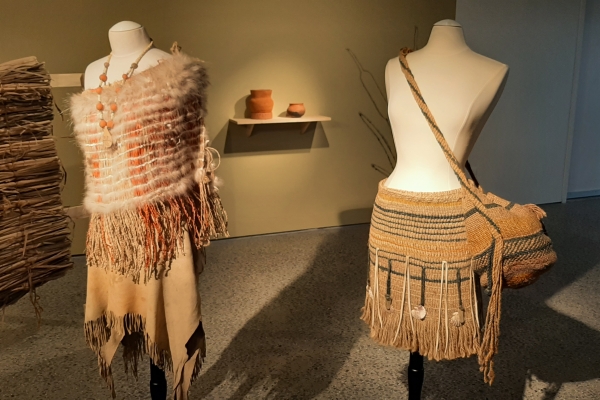The Lenfest Center Presents ‘Indigenous Dress and Culture’ The pop-up exhibit will be on view in Kamen Gallery beginning Sept. 1 and is part of the Lenfest Center’s Outreach & Engagement Series.
The Lenfest Center at Washington and Lee University presents “Indigenous Dress and Culture,” a pop-up exhibit in the Stan Kamen Gallery (located in the Lenfest Center lobby) on view from Sept. 1 through Dec. 23.
The exhibit is free and open to the public from 9 a.m.-4 p.m. Monday through Friday and during Lenfest Center performances. The exhibit will be closed on university holidays.
“Indigenous Dress and Culture” is part of the Lenfest Center’s Outreach & Engagement (O&E) Series, which is focused on connecting the university and broader community in a mutually beneficial partnership that is immersive, participatory and empowering, and fosters collaborative dialogue, feedback and decision-making. The O&E series also ushers in new ways for W&L’s campus to celebrate Native American histories and cultures leading up to Indigenous Peoples’ Day on Oct. 14, Native American Heritage Month in November and beyond, and the pop-up exhibition is accompanied by the Lenfest Center’s first Indigenous-centered and Indigenous-led performance by the Red Sky Performance company on Oct. 8.
“Indigenous Dress and Culture” features artistry crafted, collected and shared by Victoria Last Walker Ferguson, a citizen of the Monacan Indian Nation; Elizabeth Wislar, costume designer and costume shop manager at W&L and a citizen of the Northern Cherokee Nation; and Harvey Markowitz, professor of anthropology emeritus at W&L who – with Joseph Guse, professor of economics – has sponsored a Spring Term course that travels to the Oglala Pine Ridge and Tohono O’odham reservations.
Ferguson’s collection of traditional and modern-day Monacan regalia shares generations of historical and cultural knowledge passed down from her ancestors, the first peoples of the mid-Atlantic region. Each piece was created by Ferguson and is displayed to acknowledge and honor the past, present and future contributions to the region by the Eastern Siouan- and Tutelo-speaking peoples, including the Monacan.
Clothing options worn by the Indigenous people of Virginia’s interior evolved over the centuries of European occupation and colonization. Examples of early clothing options highlight the use of natural resources and are made from the inner bark of basswood trees, hemp fibers dyed with natural colors and brain-tanned deer hides. With the arrival of the Europeans and their trade goods, Indigenous clothing began to change, and glass beads and metal items such as hawk bells and trade silver were early additions to garments. The clothing options evolved to include wool, ribbons, deer hides and kilos of glass beads, and the beadwork is filled with symbolic images.
Alongside Ferguson’s pieces will be a large-scale textile sculpture created by the students in W&L’s Department of Theater, Dance and Film Studies, under the mentorship of Wislar. The dress is 12 feet tall and 4 feet wide and consists of 365 handmade metal cones, fabric, metal, wood, buttons and beads. The dress is modeled after a traditional Native American jingle dress honoring and bringing attention to Missing and Murdered Indigenous Women and Relatives.
Markowitz’s collection includes beadwork from the Rosebud and Pine Ridge reservations, modern paintings by Navajo painter Leland Holiday and traditional baskets created by citizens of the Tohono O’odham Nation. These items draw on the millennia of values and connections between the cultures and environments shared by the Indigenous peoples of North America.
“Indigenous Dress and Culture” is sponsored in part by the Class of 1964 Performing Arts Fund, W&L’s Native American Indigenous Cohort within the Office of Inclusion and Engagement, the Department of Art and Art History, the Latin American and Caribbean Studies program, the Leyburn Scholars Program in Anthropology, the Office of Community-Based Learning, the Museums at W&L, the Office of Sustainability and the University Library.
For a full list of this season’s events and performances, visit the Lenfest Center’s website.
The Lenfest Center for the Arts, home of the Department of Theater, Dance, and Film Studies and the Department of Music and Department of Art and Art History is a multi-use facility designed and equipped to accommodate a broad spectrum of the performing arts, including theater, musical theater, opera and operetta, choral and band music, dance and performance art in one energizing complex.
 (l) Brain-tanned deerskirt; top is made from bass wood and twined with opossum fur; necklace is local clay and snake vertebrae. (r) Hand-twined hemp skirt and bag with natural dyes and shells. Photo by Victoria Ferguson.
(l) Brain-tanned deerskirt; top is made from bass wood and twined with opossum fur; necklace is local clay and snake vertebrae. (r) Hand-twined hemp skirt and bag with natural dyes and shells. Photo by Victoria Ferguson.
You must be logged in to post a comment.